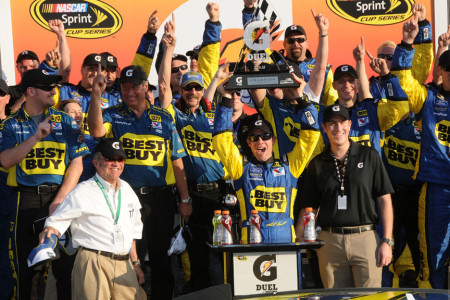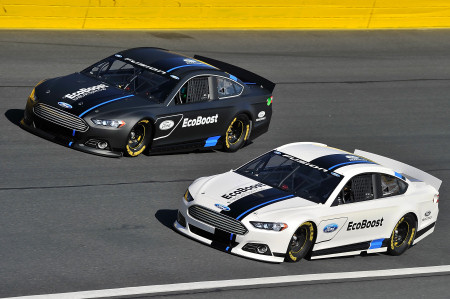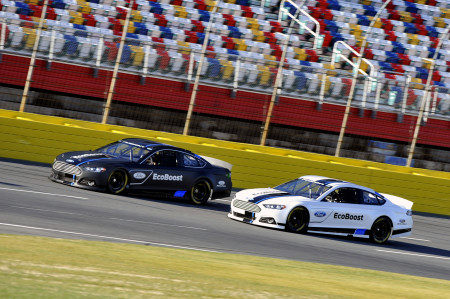The Way It Is/ Kenseth's Daytona win & NASCAR's 2013 carby Gordon Kirby |
 This is the last year for NASCAR's homogeneous 'Car of Tomorrow', introduced in 2007. Next year will witness the arrival of a new Sprint Cup car with more brand identity and a sleeker, more attractive shape. At Daytona two weeks ago I spent some time exploring NASCAR's 2013 car but before getting into that I want to review Matt Kenseth's Daytona victory.
This is the last year for NASCAR's homogeneous 'Car of Tomorrow', introduced in 2007. Next year will witness the arrival of a new Sprint Cup car with more brand identity and a sleeker, more attractive shape. At Daytona two weeks ago I spent some time exploring NASCAR's 2013 car but before getting into that I want to review Matt Kenseth's Daytona victory.
Daytona rarely provides much insight into the long season to follow but the combination of Carl Edwards' championship challenge last year allied with Kenseth's powerful win in the 500 and a front row sweep by Roush Fenway teammates Edwards and Greg Biffle dares to suggest that Jack Roush's operation may be in position to beat the top Chevrolet teams to this year's Sprint Cup drivers and manufacturers' titles for the first time since 2004. "We had a really fast car all day," Kenseth commented after winning at Daytona. "Our car for some reason was a lot faster out front than it was in traffic. It took a long time to get to the front, but once we got in front it was hard for any of the others cars to get locked onto us and to push me and stay locked onto my car. "The car had a lot of speed. Doug Yates and the guys in the engine shop deserve a lot of credit. They did a great job with the engine. It really would go through the gears good and really restarted good, which was a key on all the restarts."  © Paul Webb "The testing results over the winter were very encouraging," Roush said. "We brought better Ford Fusions than we've ever had here and we had more power relatively speaking than we've ever had. Doug and the guys in the engine shop did a really super job. Tonight, Matt had the best car and Greg was unselfish and worked with him. They pulled it off together." Ford Racing's chief aerodynamicist Bernie Marcus has worked intensively on both the 2013 Ford and Roush Fenway's Daytona cars for this year. Marcus emphasized that it was the total package that resulted in Kenseth's Daytona victory. "Obviously, everybody has worked very hard," Marcus commented. "The bodies themselves were a little better than they were last year. They had less drag and we worked on the cooling system and the engine guys worked on the engine. It's the whole package. Every department at Roush Fenway and Ford has worked really hard on this and it was nice to see it come right." I asked Marcus if the Roush Fenway Fords enjoyed any measurable advantage at Daytona. "I don't know," he replied. "It's very hard to quantify. We can't simulate cars running in turbulence like that and when you've got 43 cars running around with all that turbulence you just don't know how big an effect any aero or duct work you've done may have. "I saw less steam coming out of our cars than I saw of the competition during Speedweeks. But there again, Matt had a problem early in the race when he lost a lot of water. He pitted and water was coming out the overflow and they had to refill and repressurize the water system. Normally, when you have to do that in a race you never get it full again or get it right. But luckily, it worked out for him." Marcus said Ford's engineers and Doug Yates' engine men put a lot of effort into improving the cooling efficiency of the latest Ford NASCAR engine.  © autostock "So they worked very hard on getting that right. When the FR9 engine came out even last year with the cooling package the cars could run much longer coupled up than others. So that's part of it plus the aero work we did with the cooling ducts which we spent quite a lot of time on." Marcus believes Roush Fenway has a shot at this year's championship if the team can perform better on short tracks. "Roush have always been good at the bigger tracks, the mile and a halfs, the two miles and the 2.5-mile tracks," Marcus observed. "But the mile tracks have been a bit of a struggle and Martinsville and the road courses too. But they have improved. Last year they worked really hard and the cars ran really well at Phoenix and Loudon was better too. "The only real weak point I see is Martinsville. They've always struggled a bit there. But Kenseth ran in the top five in the fall race there until he got crashed, and if you can run in the top five in this series you're doing pretty well. So there is room for improvement, particularly on the shorter tracks. But the work carries on. They've got new cars built for Talladega and we're always looking ahead to doing new stuff." Moving on to the 2013 Cup car I have to say I was impressed to hear how pleased NASCAR and the manufacturers are with the process of developing the new car's shape and layout. TRD's president Lee White expressed the manufacturers' enthusiasm. "The 2013 car has probably been the most amazing collaboration we've ever seen," White declared. "There's been a truly remarkable degree of cooperation with everyone pulling on the same end of the rope to get that to happen so the manufacturers are finally going to get some real brand identity in the cars that we haven't had for five years with the CoT. If there was an issue we needed to get it out on the table we did it. Everyone worked together really well. That's the level of cooperation we saw." NASCAR's vice-president of competition Robin Pemberton agreed with White's assessment. "The way we do things now is a collaborative effort among us and the manufacturers," Pemberton said. "We are more in control of the testing when it's our chassis and our cars and the changes to the bodies and all tests are done with all the manufacturers there at the same time so that everybody knows and sees what everybody else is doing. We like to say we don't want to see anyone disadvantaged and the process that we used on the new Nationwide car and on the move to electronic fuel injection has worked really well. We've taken it to the next level this time around with the new Cup car. "It's important for the manufacturers to get the detail back in the car and for it to look more like what they're selling in the showrooms. We're in the middle of a lot of wind tunnel tests and making comparative analysis of the cars. We feel like we're close. We're not all the way there yet, but from the numbers that we've seen we're not far apart with all the four makes that are currently participating. It's been a good process."  © autostock "About every quarter we've had meetings with NASCAR," White related. "At the first one we sat around the horseshoe table at the NASCAR tech center and Daniel Honeycutt, their aero guy, and Mike Fisher took the podium and told us what they were doing. Then the manufacturers put their case forward. We said, 'This is what we think,' and John Darby and Pemberton basically said, 'We're with the manufacturers.' "They said they liked what the manufacturers had brought to the table. They wanted us to keep them in the loop. So we couldn't be more pleased. Frankly, that's the way the thing came down." Bernie Marcus explained Ford's approach to the 2013 car. "Obviously, the whole goal was driven by the fans and the manufacturers," Marcus said. "Everybody wants more brand identity in the race car. The manufacturers said let's not allow what happened with the CoT where we weren't really working together that well and allowed the whole thing to be driven by NASCAR. The result was they came up with a vanilla shape with the greenhouse, nose and tail. "So we went to NASCAR and said, 'Look, how can we help to do this better?' And we all decided to work together by first of all getting some architectural things nailed down. We made the greenhouse a little sleeker and the windshield angles a little shallower, more in line with what you actually see on the street. "The current car is disproportionate because the tail is so long and the nose overhang is so short. So we moved things around and made the nose a little longer and tail a little shorter. We came up with a very basic framework of dimensions, sizes and shapes and we commonized the greenhouse, nose and tail surrounds. "We still have to work to some common areas because the cars need to be aero-matched and we need to do it with the same spoiler and splitter sizes. NASCAR made it very clear to us that they do not want to go back to the old days when people had different spoiler heights and sizes." Lee White added his perspective on the process of defining the new car's shape. "Three or four months were spent just redefining the greenhouse so you can have a common greenhouse that accomodates the look of all the manufacturers," White said. "The squared-off windshield is gone at the front. With the current car the base of the windshield is flat and square. Now there's going to be curvature or wraparound to it which are all the same." White said initial testing has gone well and NASCAR is now settling on the 'hard points' to establish its definition of the new car.  © "NASCAR is going to impose hard points so the aero characteristics can be developed in a small box. They want to keep the competition as tight as they can. It doesn't matter to NASCAR whether it's metal or plexiglas, as long as the hard points fit you can take that shape and make it look like anything you want. It can be lexan or metal. They don't care. "But it took about four months for NASCAR and the manufacturers to get to the pont where everybody was happy with the greenhouse hard points. You can put your own character into the side of the car and into the wheel openings and the front bumper. Those will be unique to each manufacturer." Bernie Marcus commented on NASCAR's definition of hard points and also talked about early testing results. "When the length, height, width and the wheel arch eyebrow shape are all common and the greenhouse and deck lids are common it doesn't leave you an awful lot of freedom to make any significant gains with either downforce or drag," Marcus observed. "And testing showed that. About a month ago we had the first OEM comparison tests where we brought all our pieces and mounted them on a car and ran them, and we were all very close. Considering how different the cars looked we were very close in downforce and drag. "We had a wind tunnel test in the last week in January and tested at Homestead on February 1st where everybody brought a 2013 car. Kenseth drove our car and he liked it. They put the setup in the car from last November's race and he liked it. He said it drives very similar to the current car and feels good. He had nothing bad to say. It was all good. They ran in traffic with four cars and he said even in traffic it worked very well. So that was all encouraging. "Sometime in the summer," Marcus added, "we'll probably have a test somewhere with everybody running three or four cars. That will be more representative of when you do race trim runs." Plenty of detail development work remains to be done. "We're going back to the wind tunnel this week and running some more different options for NASCAR," Marcus said. "We've done a couple of refinements. For example, the car that we ran was just like a stock car with decals and our design people wanted to look at putting in some grille bars to make it more like a street car.  © autostock The package for next year's restrictor plate tracks has yet to be determined but Marcus surmises that the differences in the noses and tails of the 2013 cars will be significant enough to change the nature of push or bump-drafting on superspeedways. "We don't really know anything yet about what they want to do with spoiler and cooling packages and the bumping and so on," Marcus said. "After we've spent all this time and effort designing these new cars I sure hope we don't end up cutting holes in the bumpers for the first race. That's something we'll have to work through with NASCAR. "One thing is the bumper heights are all different on each car. So they won't line up very well like the current car does and that may eliminate a lot of the bump-drafting. But what we want cooling-wise is something we need to work with and figure out what we need there in an elegant way without just cuffing holes in the bodywork." In contrast, Marcus says Ford is well down the road on establishing the short track configuration for its 2013 car. "The biggest difference with the short track car is the brake cooling," he remarked. "We are working on some brake cooling ducts and some different options to put them in the nose without destroying the look. We've done some wind tunnel testing with that and also some CFD work. We're pretty well down the road on the short track package and what we can do and what we think we need." In closing I have to repeat my mantra from last week. NASCAR has a clear vision of what it wants to happen on the racetrack and a powerfully effective way of governing and working with its competitors. For sure it has its problems, but NASCAR's method of managing the racing side of its business is unparalleled in American motor racing. That's why NASCAR has become the brand name for racing in the United States. |
Auto Racing ~ Gordon Kirby Copyright 2012 ~ All Rights Reserved |
